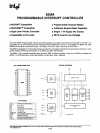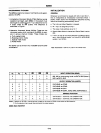
8259A
INITIALIZATION COMMAND
WORDS
1 AND 2
(ICW1,ICW2)
As-A1S:
Page
starting address
of
service routines.
In
an
MCS
80/85
system, the 8 request levels will generate
CALls
to 8 locations equally spaced in memory. These
can
be
programmed to be spaced at intervals
of
4 or 8
memory locations, thus the 8 routines
will occupy a
page
of
32
or
64
bytes, respectively.
The
address format is 2 bytes long
(Ao-A1S)'
When the
routine interval is
4,
Ao-A4 are automatically inserted by
the
8259A,
while A
s
-A
l
s are programmed
externally.
When the routine interval Is
8,
Ao-As are automatically
inserted by the 8259A, while A
6
-A
1S
are
programmed
externally.
The
a·byte interval will maintain compatibility with cur-
rent software, while the 4-byte interval is best for a com-
pact jump table.
In
an
MeS-86 system A
1S
-A
ll
are inserted in the five
most significant bits
of
the vectoring byte and the
8259A seis
ilie
iI"""
illasi signiiicant bits accorolng to
the interrupt
level. Al0-As are ignored
and
ADI (Address
Interval) has no effect.
L
TIM: If L
TIM
=
1,
then the 8259A will operate in the
level Interrupt mode. Edge detect logic on the
Interrupt Inputs will
be
disabled.
ADI: CALL address Interval. ADI = 1 then Interval =
4;
ADI
= 0 then Interval =
8.
SNGL: Single. Means that this Is the only 8259A
In
the
system.
If SNGL= 1 no ICW3 will be Issued.
IC4:
If this bit Is set -
ICW4
has to
be
read.
If
ICW4
Is not needed, set IC4 =
O.
AO
D7
De
D5
D4
I 0
A7
Ae
A5
I
I 1
A15
1114
A13
A12
INITIALIZATION COMMAND
WORD
3 (ICW3)
This word is read only when there is more than one
8259A in the system and cascading is used, in which
case
SNGL =
O.
It will load the 8-bit slave register.
The
functions
of
this register are:
a.
In
the master mode (either when
SP
=
1,
OJ in buttered
mode when
MIS
= 1 in
ICW4)
a
"1"
is set for each
slave in the system.
The
master then will release byte
1
of
the call sequence (for
MCS-SO/S5
system) and
will enable the corresponding slave to release bytes 2
and
3 (for
MCS-S6
only byte
2)
through the cascade
lines.
b.
In
the slave mode (either when
SP
=
0,
or
if
BUF = 1
and
MIS
= 0 in
ICW4)
bits
2-0
identify the slave. The
slave compares its cascade
Input with these bits and,
if
they are equal, bytes 2 and 3
of
the call sequence (or
just byte 2 for
MCS-86)
are released by
it
on
the Data
Bus.
INITIALIZATION COMMAND
WORD
4 (lCW4)
SFNM:
If
SFNM = 1 the special fully nested mode Is
programmed.
BUF: If BUF = 1 the buffered mode is programmed.
In
buffered mode
SP/EN
becomes
an
enable output
and the masterlslave determination Is by
MIS.
MIS:
If buffered mode Is selected:
MIS
= 1 means the
8259A is programmed
to
be
a master,
MIS
= 0
means the 8259A is programmed to
be
a siave. If
BUF =
0,
MIS
has no function.
AEOI:
If
AEOI
= 1 the automatic end
of
Interrupt mode
Is programmed.
,",PM:
Microprocessor mode:
,",PM
= 0 sets the
8259A
for
MCS-80/85
system operation,
,",PM
= 1 sets
the 8259A for
MCS-86
system operation.
D3 D2
Dl
DO
lTIM
ADI
SNGl
IC4j
ICWI
All
Al0
AI
AljlCW2
r----------(-~~.~~
....
I 1 S7
se
SS
54 S3 52
SI
so
j'CW3
~--------------------r-t------------------~
,.------------~~~
~."
I 1
I
Figure
1_
Initialization Sequence
SFNM
aUF
t
READY
TO
ACCEPT REQUESTS
IN
THE
FUllY
NESTED
MODE
9-44
MIS
AEO'
I


















